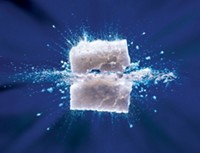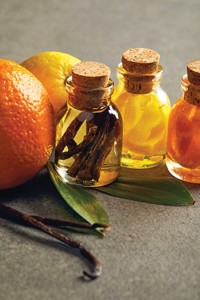Advertisement
Grab your lab coat. Let's get started
Welcome!
Welcome!
Create an account below to get 6 C&EN articles per month, receive newsletters and more - all free.
It seems this is your first time logging in online. Please enter the following information to continue.
As an ACS member you automatically get access to this site. All we need is few more details to create your reading experience.
Not you? Sign in with a different account.
Not you? Sign in with a different account.
ERROR 1
ERROR 1
ERROR 2
ERROR 2
ERROR 2
ERROR 2
ERROR 2
Password and Confirm password must match.
If you have an ACS member number, please enter it here so we can link this account to your membership. (optional)
ERROR 2
ACS values your privacy. By submitting your information, you are gaining access to C&EN and subscribing to our weekly newsletter. We use the information you provide to make your reading experience better, and we will never sell your data to third party members.
Business
Artificial Ingredients In The Crosshairs
Food: Responding to consumer demands, major food brands removed additives
by Melody M. Bomgardner
December 21, 2015
| A version of this story appeared in
Volume 93, Issue 49

This holiday season will be a little less colorful, at least in the grocery store. Earlier this year, General Mills and Kellogg’s—both makers of rainbow-hued cereals aimed at kids—vowed to remove artificial colors and flavors from many of their products. Naturally colored versions of General Mills’ Trix cereal, among others, will hit shelves later this winter.
In a similar move, food giant Kraft said it will remove synthetic colors from its iconic macaroni and cheese dinners starting in January. Chocolate lovers may notice that holiday versions of Hershey’s Kisses will not contain ingredients such as synthetic vanillin. Even fast-food chains Taco Bell and Pizza Hut promised to nix additives.
Food makers stress that they are reformulating recipes in response to growing consumer preferences, not because the artificial ingredients pose a risk to health.
General Mills said its own research shows “49% of households are making an effort to avoid artificial flavors and colors from artificial sources.” Consumer trends consultancy Mintel cites similar data. Outside the U.S., it points out, brands such as Nestlé moved more quickly to make similar changes.
It can take quite a bit of food science to address consumers’ wishes. Synthetics are generally inexpensive, stable, effective in small amounts, and Food & Drug Administration-approved. Researchers are now turning to colorings made from fruit and vegetable juices or colorful spices such as turmeric. Recipes may require significant reworking because natural colors can add undesirable flavors or degrade during processing. The cost and availability of natural ingredients also pose challenges.
For ingredient suppliers, however, the turn toward so-called “clean labels” is an opportunity to develop new products and grow once-niche businesses. In France, Solvay is increasing production of its natural vanillin made from ferulic acid derived from rice bran. Earlier this year, agriculture giant Cargill and biotech ingredient firm Evolva began work on a facility to produce stevia, a no-calorie sweetener normally obtained from the stevia plant, using microbial fermentation.
C&EN's YEAR IN REVIEW
Top Headlines of 2015
- Chemical Makers Looked To Big Deals
- NASA Got Up Close And Personal With Pluto
- Opposition To Neonicotinoids Intensified
- 2015 Nobel Prizes In Science At A Glance
- Climate Pact Clinched
- Little Good News For Chemistry Job Outlook In 2015
- Pfizer To Merge Again, This Time With Allergan
- Oil And Gas Industry Under Pressure
- Greening Up Fracking
- An Industry In Spin Cycle
- Finally, Emoji For Chemists
- A Big Deal For Chemists
- Tianjin Explosion Put Spotlight On Safety
- Women Assumed Leadership Roles At American Chemical Society
- Artificial Ingredients In The Crosshairs
- Jacqueline K. Barton, Unwavering Chemistry Champion
- House Science Committee Chair Pummeled Science Agencies
- NIST Veteran Became U.S. Government's Top Chemist
- Gene-Editing Technique Raised Ethics Questions
- World Chemical Production At A Glance
- Classroom Fires During Science Demonstrations Spark Concern
- Climate Was Right For Deal-Making
- American Chemical Society Dives Deeper Into Open Access With The Debut Of ACS Omega
- Lego Began Research On Switching To A Biobased Plastic
- New Chair Took The Helm At Troubled Chemical Safety Board
- Genetically Modified Foods In The Spotlight
- Overhaul Of U.S. Chemical Law Moved
- ACS Scholars Program Turned 20
- American Chemical Society Expanded Its Global Reach
- Scientists Called For Standardized Antibodies
Top Research of 2015
- Flexible Electronics You Can Inject
- Special Delivery For Sensitive Reagents
- Yeast Programmed For Opioid Total Synthesis
- Miracle Machine Builds Molecules On Demand
- Nickel Shines As A Catalyst
- 3-D Printing Takes On A New Dimension
- Atomically Thin Films Grow In Number
- Digging In The Dirt Yields Novel Bacteria Fighter
- Keeping GMOs On A Leash
- A Liquid With Holes In It
- Electron Microscopy Provides Unprecedented Close-ups
Revisiting Research of 2005





Join the conversation
Contact the reporter
Submit a Letter to the Editor for publication
Engage with us on Twitter